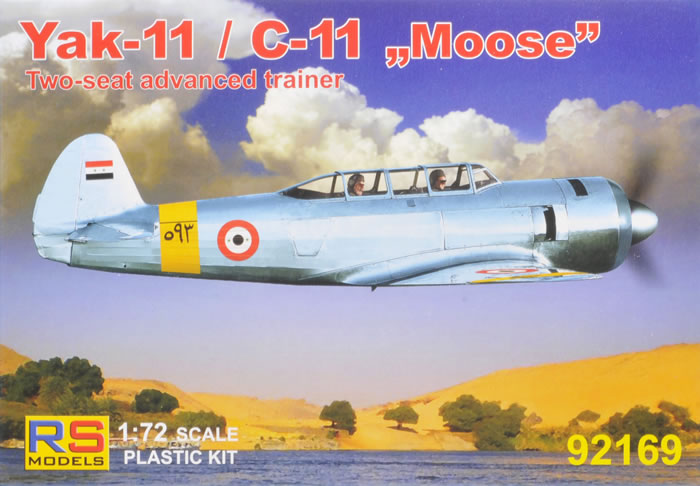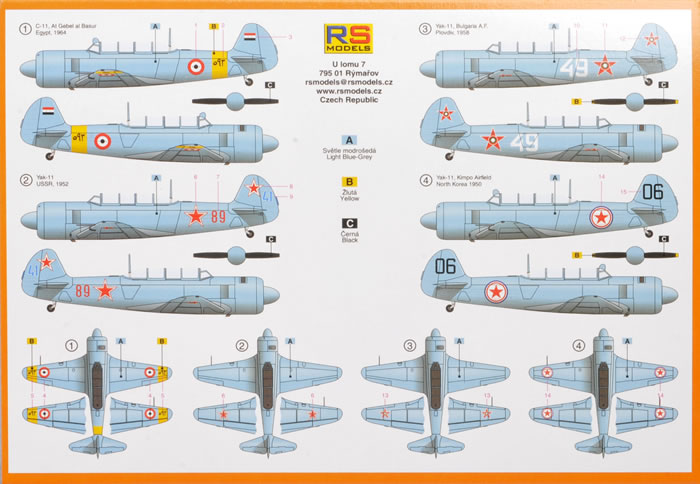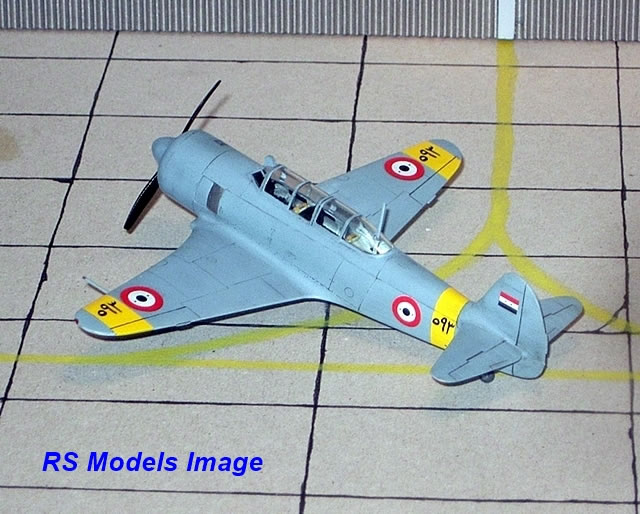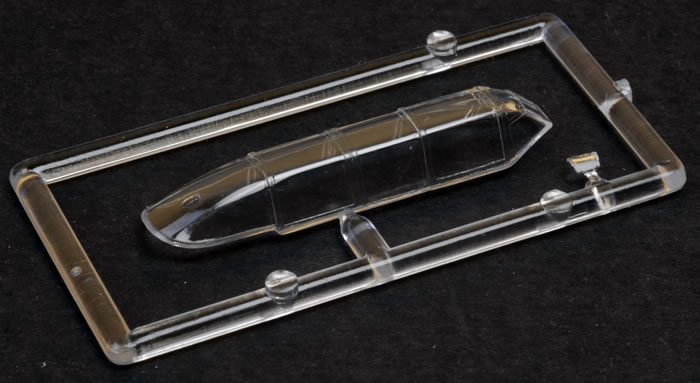|
Yak-11 / C-11 “Moose”

RS Models, 1/72 scale
S u m m a r y : |
Catalogue Number: |
RS Models Kit No. 92167 – Yak-11 / C-11 “Moose” |
Scale: |
1/72 |
Contents & Media |
52 tan coloured plastic parts; two clear styrene parts; one PE fret; decals for four subjects. |
Price: |
Available on-line from these stockists:
|
Review Type: |
First Look |
Advantages: |
Very fine surface detail, and a nice cockpit. |
Disadvantages: |
No open engine shutter option. |
Conclusions: |
This is a simple and good quality kit. It has commendably fine surface detail with a nicely detailed cockpit. I would not expect any significant difficulties with its construction. It is a pity that there is no option for open shutters in the mouth of the engine cowling however. But this is not enough to stop me highly recommending it.
|
Reviewed by Mark Davies

RS Models 1/72 scale Miles Magister is available online from Squadron.com
Background
The Yakovlev design bureau began work on an advanced trainer based on the successful Yak-3 fighter in mid 1944, although the trainer was of low priority owing to the ongoing Second World War. The first prototype of the new trainer, designated Yak-UTI or Yak-3UTI flew in late 1945. It was based on the radial-powered Yak-3U, but with the new Shvetsov ASh-21 seven-cylinder radial replacing the ASh-82 of the Yak-3U. It used the same all-metal wings as the Yak-3U, with a fuselage of mixed metal and wood construction. Pilot and observer sat in tandem under a long canopy with separate sliding hoods. A single synchronized UBS 12.7 mm machine gun and wing racks for two 100 kg (220 lb) bombs comprised the aircraft's armament.

An improved prototype flew in 1946, with revised cockpits and a modified engine installation with the engine mounted on shock absorbing mounts. This aircraft successfully passed state testing in October 1946, with production beginning at factories in Saratov and Leningrad in 1947.
Production Yak-11s were heavier than the prototypes, with later batches fitted with non-retractable tail wheels and revised propellers. A 7.62 mm ShKAS machine gun was sometimes fitted instead of the UBS, while some were fitted with rear-view periscopes above the windscreen. In total, Soviet production amounted to 3,859 aircraft between 1947 and 1955; with a further 707 license-built by Let in Czechoslovakia as the C-11.
The Yak-11 set five world-class records.
Source: Wikipedia
Previous 1/72 Yak-11 Kits
The Yak-11 has been surprisingly well served in “The One True Scale” over the years. RS models first released their Yak-11 kit about a year ago, but I am aware of eleven other kits that have preceded it, plus one that is to be released within the near future. These are its by:
-
A+V (early resin),
-
ABC Modelfarb (limited run),
-
Aeroteam (limited run, builds OK),
-
Airmodel (vac-form),
-
Broplan (vac-form),
-
Classic Plane (limited run),
-
CMR (early resin kit),
-
High Planes Models (limited run modified racers),
-
Micro Mir (soon to be released limited run),
-
Model Aire International (resin),
-
Waku (vac-form, builds well), and
-
Warrior (limited run).
Contents
The kit comes in an end-opening box with appealing artwork on the front and a colours & markings guide on its rear. The instructions provide a parts map, and use an easy to follow diagrammatic assembly format with English text. There is also a very brief history of the aircraft. The painting and markings guide is quite adequate, but only offers generic colour call outs. The boxing reviewed here shares its parts with three other boxings by RS Models; these being 92168 , 92166, and 92165, of which all but one are priced the same as the review boxing, whilst 92166 is 3 Euros less.

I have numerous RS kits, and this one is quite typical of the brand. The parts come on three sprues, two tan and one clear. They are cleanly moulded with very fine surface detail, and narrow sprue gates. The canopy is acceptably thin and quite clear. Parts break down is conventional and limited run in nature; lacking locating pins etc. The decal sheet appears to be of good quality too.
The Kit
On examining the sprue my first impressions were very positive. The panel lines on the metal surfaces are very fine and consistent. The fabric covered rear fuselage section is subtle and convincing; as are the fabric covered control surfaces, with just delicate rib tapes represented.
The cockpit is nicely detailed with a floor, control columns, rudder bars, seats with separate padding, side framing with consoles, instrument panels with raised detail and separate coaming, plus rear bulkhead and decking. There is also a gun-sight for which the reflector glass must be scratch-built. All that need be added is a pair of seat harnesses.
The engine cowl is moulded with its cold weather shutters closed, so there is no radial engine to worry about. However, I could not help but wonder if these would be removed or left open in warmer climates, such as in the case of the Egyptian version this boxing caters for. From what I can determine the closed shutters retract behind the spinner when fully open, or can be left partially open. It is a pity RS Models did not cover the open option as well.
Two cooling gills fit either side of the fuselage behind the cowling. Two exhaust pipes and an antenna mast fit on the fuselage underside, along with a flap that fits to a vent in the wing’s centre-section, and of course the tail-wheel. The canopy is designed to sit over the antenna mast that is mounted on the internal rear cockpit decking. There is an optional large rear vision mirror that can be fitted to the windscreen. A quite finely moulded props and spinner finish off the fuselage side of things. There is also a spare square-tipped prop that must relate to one of the other boxings.

The wings enclose separate wheel-wells that have quite reasonable structural detail included. The undercarriage and main wheels look fine, and the wheel doors have detail on their internal faces. There is the mouth of the carb-air intake to fit to the port wing-root, plus a landing light and pitot, also fitted to the port wing. Two small payload racks that fit just outboard of the wheel-wells complete the wing assembly; but no stores of any kind are supplied. All that is left are the horizontal stabilisers which happen to have very small locating tabs to match slots in the fuselage.
I would expect this to build well for a limited run kit based on my experience of similar types by RS Models. The finished results are appealing as evidenced by this RS Model image of the finished model:
Colours & Markings
Four decal options are provided for Egypt, USSR, Bulgaria, and North Korea; these being:
-
Arabic Ser No, At Gebel al Basur, Egypt, 1964
-
Red 89, USSR, 1952
-
White 49, Plovdiv, Bulgaria, 1958
-
Black 06, Kimpo Airfield, North Korea, 1950

All four schemes are overall light blue, with only Egyptian option having a splash of colour from its yellow fuselage band. The decals appear to be excellent, and my prior experience of the brand would suggest that they should perform well.
This is a simple and good quality kit. It has commendably fine surface detail with a nicely detailed cockpit. I would not expect any significant difficulties with its construction. It is a pity that there is no option for open shutters in the mouth of the engine cowling however. But this is not enough to stop me highly recommending it.
Thanks to RS Models for the review sample
Review Text Copyright © 2015 by Mark Davies
Images Copyright © 2015 by Brett Green
Page Created 27April, 2015
Last updated
27 April, 2015
Back to HyperScale Main Page
Back to Reviews Page

|
